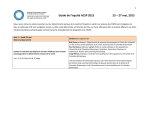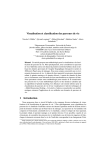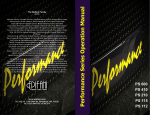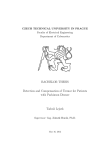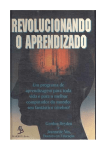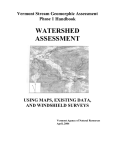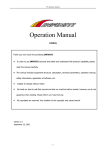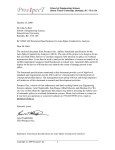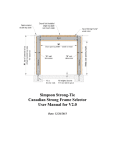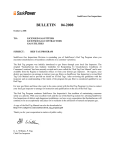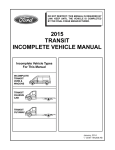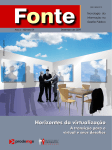Download June 2010 - Education and Advanced Learning
Transcript
THE SIGNAL June 2010 T he S c h o o l B u s M o t t o : In This Issue . . . Congratulations, Conferences, Committees, and a Safe Summer .. 1 2010 School Bus Order ................. 2 School Bus Maintenance Seminar . 2 School Bus Driver Instructors’ Program ......................................... 2 School Bus Inspection Log Book – New Format .................................... 3 Updated School Bus Safety Bibliography ................................... 3 School Bus Driver’s Handbook ...... 4 People on the Move ....................... 4 Thomas School Bus FS65 Cracking Around Hood Hinges ...................... 5 Articles............................................ 5 Got Bus Laptop Computers – “The New Crescent Wrench” Getting the Maximum from an Emergency School Bus Drill Appendices “A B C – Always Be Careful” Congratulations, Conferences, Committees, and a Safe Summer The 2009/10 school year is drawing to a close and while school divisions are busy wrapping up the business of one school year and turning their focus on a new one, it is an opportunity for me to reflect. Once again, school divisions across the province have successfully provided 60,000 students a safe means of getting to and from school for approximately 180 days. School bus drivers have travelled about 33 million kilometres on every type of road and in every condition that Manitoba’s climate can present. Daily routes are further complicated by differing student needs and alternating transportation arrangements. School divisions have clocked untold distances meeting the needs of extracurricular and sports trips. Everyone involved in school division transportation should commend themselves for turning those challenges into a safe and successful year. Last month I had the opportunity to attend my first Canadian Pupil Transportation Conference in Ottawa. A variety of discussion topics were presented and an elaborate trade show hosted numerous trade-related vendors. Guest speakers Brian Williams of CTV/TSN and Rex Murphy of CBC/National Post provided meaningful presentations about the great country we live in and the opportunities we have. The agenda covered every conceivable topic: Professional Instruction in Driver Education, Continued on Page 5 The Signal – June 2010 WHAT’S PTU BEEN UP TO? 2010 SCHOOL BUS ORDER International (Maxim Truck & Trailer) has been awarded the contract to supply regular and wheelchair IC school buses to school divisions participating in the Department’s central tender process. Thirteen school divisions are purchasing a total of 39 buses through the tender. It is anticipated the buses will begin arriving at Maxim in late August. Sandy Campbell and Rick Penner travelled to Tulsa, Oklahoma the week of May 10th to conduct a pilot model review and assembly line audit at the IC school bus plant. They were fortunate to meet with engineers from IC to address the concerns Manitoba has been experiencing on its fleet of IC buses. Continued on Page 4 SCHOOL BUS MAINTENANCE SEMINAR The 2010 School Bus Maintenance Seminar held March 29-30 in Brandon and March 31April 1 in Winnipeg attracted 33 and 49 participants respectively. (See Appendix A for seminar evaluation results.) Presenters included Blue Bird Corporation; Navistar Canada Inc.; Thomas Built Buses; STEMCOKAISER; and PTU. Mechanics attending this year’s seminars expressed a desire for follow-up to questions posed at the Open Forums. Appendix B contains answers to many of those questions. PTU will provide answers to others as information becomes available. The Signal – June 2010 SCHOOL BUS DRIVER INSTRUCTOR’S SEMINAR Between September 2009 and April 2010, PTU conducted two Phase I and Phase II School Bus Driver Instructor’s Seminars in Brandon. The Fall 2009 group consisted of 9 participants; 13 participants made up the Spring 2010 group. All 22 participants took part in Phase III held May 26-28 in Gimli. Participants’ seminar evaluation comments can be found in Appendix C. PTU extends congratulations to the following new School Bus Driver Instructors: Terry Pow, Brandon S.D. Paul Humeny, Evergreen S.D. Russell Isfeld, Evergreen S.D. Pam Hurak, First Student Canada Roger Van De Kerckhove, Frontier S.D. James Fiddler, Garden Hill F.N. Rick Batters, Garden Valley S.D. Carolyn Sigurdson, Lakeshore S.D. Teresa Shawara, Louis Riel S.D. Jim Crozier, Mountain View S.D. Rick Hrycak, Park West S.D. Don Hickey, Pine Creek S.D. Wayne Taylor, Prairie Rose S.D. Lisa Hanna, Red River Valley S.D. Dale Desjardine, River East Transcona S.D. Wayne Pearen, Seine River S.D. Robin Cyr, Sunrise S.D. Alex Sousa, Turtle River/Rolling River S.D. Fred Hiebert, United Transportation Driver Training Jim Dunphy, Vital Transit Services Ltd. Chris Hagen, Pupil Transportation Unit Rickey Penner, Pupil Transportation Unit Page 2 PTU PUBLICATIONS UPDATE SCHOOL BUS INSPECTION LOG BOOK – NEW FORMAT UPDATED SCHOOL BUS SAFETY BIBLIOGRAPHY The new log book will be 8.5” x 5.5” in size and will include a two-part carbonless copy report format. The top copy will be perforated for removal and submission to the school division office; the underlying copy will remain in the log book. Information contained in the log book will remain largely unchanged; however, the pre-trip inspection checklist has undergone two changes: The School Bus Safety Bibliography has been updated by the Instructional Resources Unit (Library) of the Department. A number of new titles have been added: Outside Checks - Windshields Acceptable Condition – Star or chip less than 25 mm (1 inch) Out Of Service Condition – Two stars and/or chips greater than 25 mm (1 inch) or any intersecting cracks in driver’s vision or wiper sweep area Outside Checks – Headlights Headlights category has been removed from this section. Refer to the checklist’s Outside Checks Required Before Driving Away for information on headlights. On June 11th, PTU emailed transportation supervisors information on the new log book format. Distribution is expected to occur in August. PTU extends thanks to Curtis Basso for his efforts in providing the first draft of the log book. A large portion of the work was complete prior to PTU finalizing this version. Note that school divisions may choose to continue using the current binder with photocopied pages. The Signal – June 2010 DVD/Video Kits Operation Lifesaver Professional Drivers Program Out of Sight, Out of Mind: The Critical Issues of Leaving Children on Buses DVDs/Videos Bloodborne Pathogens for School Bus Drivers: The Route to Safety Child Safety Restraint Systems Dealing with Young Riders - Communication; Dealing With Groups; Disruptive Behaviour; Giving Directives; Rules, Rapport and Reason Defensible Use of Force on the Bus Evacuating the School Bus Make It a Round Trip: School Bus Driver Safety at Highway-Railway Crossings Preventing Road Rage: Anger Management for Drivers Riding Your School Bus Safely Safe Exit From Vehicle: School Bus Safety School Bus (IC school bus factory tour) Tears on the Highway Transporting Your Child Safety Winter Driving The Bibliography can be accessed through the PTU website at www.edu.gov.mb.ca/k12/ptu Select School Bus Safety/Ridership Education to reach the link. Page 3 PUBLICATIONS UPDATE cont’d 2010 SCHOOL BUS ORDER cont’d School Bus Driver’s Handbook PTU staff took defect information compiled from its inspection process, as well as information obtained from failed material tags and the Spring Maintenance Seminar, and put forward a presentation to IC bus personnel. IC staff were very interested in the findings since Manitoba is one of only a few customers who track school bus concerns and defects prior to delivery. The intent of the presentation was for IC to listen to PTU’s concerns, and in turn, IC would address or review the issues evolving from the findings presented. In the past few months, the School Bus Driver’s Handbook has undergone extensive revision. The context of the Handbook remains unchanged insofar as it is still presented in six units. It has a “new look” with regard to print style and title pages, and the text language has been modernized. The Table of Contents has been expanded, as has the amount of information in the Appendices. A few of the topics that have been added or revised include: an expanded section on driver licencing and acquiring a school bus operator’s certificate. a danger zone diagram. a section on bullying. a section explaining don’t pass law violations. updated pre-trip inspection diagrams. instruction on operation of school buses with manual transmissions remains in the Handbook as part of the Appendices. The Handbook is currently being collaboratively produced with the Manitoba Text Book Bureau. Once complete, PTU will be in touch with school division transportation supervisors regarding distribution and availability. Thank you to all school divisions who participated in this process. Without your communication with us many concerns would never be given attention. With data to support the concern, manufacturers are a lot more interested in listening. It can’t be stressed enough the importance of completing failed material tags and submitting them to PTU. In a perfect world we would have the perfect bus, but here in our “real world” with its harsh climate we face many challenges that many in the United States cannot begin to comprehend. This should not stop us, however, from striving towards perfection in our work. Thanks again for your input. People on the Move Sunrise School Division recently said goodbye to Jim Wright as he retired from his position as supervisor of transportation, and welcomed Gary Walker as “the new guy”. PTU welcomes you to the group of transportation supervisors, Gary, and looks forward to working with you. The Signal – June 2010 Page 4 Congratulations, Conferences, Committees, and a Safe Summer cont’d THOMAS SCHOOL BUS FS65 CRACKING AROUND HOOD HINGES Media and Crisis Communication, Using GPS Effectively, Reducing Blow By’s, Why Bus Patrols Are Essential, Training Needs, The Bus Stops Here!, Fuel Management, Outside the Bus Safety, Effects of Attitude and Lifestyle, Measuring and Evaluating Transportation Efficiency, Things to Consider About Employee Substance Abuse, a Rapid Fire Cross Country Question and Answer, Special Needs Transportation, and Grading Your Service Level. A representative from Transport Canada explained the testing being performed to increase student safety on school buses. The four days were punctuated with tours of the Parliament Buildings and Environment Canada’s Emission Testing Facility. The Conference is certainly a worthwhile experience, and I encourage you to consider attending the 2012 Conference which will be held at one of our Canadian treasures – Lake Louise. A meeting of the Canadian Standards Association’s Technical Committee on School Buses was held in conjunction with the CPTC. Discussions continue on development of the 2012 version of the D250 School Bus Standard. The 2012 version will incorporate the D409 (Standard for Motor Vehicles for the Transportation of Persons with Physical Disabilities). In closing, and on behalf of Sandy, Rick, and Vickie, I wish everyone a safe and enjoyable summer. We look forward to working with each of you again in the next school year. On some FS65 school buses, the hood may crack around one or both hinges. This cracking may be the result of pressure applied to the hood by a twisting action, possibly due to a side load caused by lack of lubrication and the act of raising and lowering the hood while standing at the side of the bus. If the hood has cracked around the hinge, refer to the hood repair procedures in Section 88.00 of the School Bus Chassis Workshop Manual. To prevent cracking around the hood hinges, repair the problem as outlined in the Freightliner Bulletin 88-3 which can be found at the end of Appendix B. ARTICLES Three articles are presented on the following pages . . . In his article Got Bus, Chris Hagen shares information on the use of multi-functional activity buses (MFAB’s) and converted school buses to transport students. Sandy Campbell weighs in on the past and present of school bus maintenance in Laptop Computers – “The New Crescent Wrench”. The third article is a two-part excerpt from the May and July 2009 editions of School Transportation News entitled Getting the Maximum from an Emergency School Bus Drill. Regards, Chris Hagen The Signal – June 2010 Page 5 GOT BUS? By Chris Hagen, Senior Field Officer, Pupil Transportation Unit PTU receives many phone calls and emails inquiring about suitable transportation of students beyond the normal morning pick-ups and afternoon drop-offs on the yellow school bus. Student transportation is provided by a number of different vehicles in a wide range of times and schedules. For some school divisions, the availability or access to a division-owned yellow school bus or a driver may not be possible at the scheduled time of an extra-curricular trip. The safest means of transporting students remains the yellow school bus. Recognizing this fact, in the past few years the Canadian Standards Association’s (CSA) Technical Committee on School Buses developed standards for the design and construction of an MFAB (Multi-Functional Activity Bus). Some jurisdictions refer to this vehicle as an MFSAB (inserting the word “School” before the word “Activity”). The applicable CSA standard is the D270. This standard was developed in a relatively short time frame because the Committee chose to adapt the existing CSA D250 (School Bus standard) to meet the needs of a bus suitable for extra-curricular trips. The two standards are similar; however, the D270 does not require as many safety devices as used on the yellow school bus for loading and unloading students. An MFAB is designed and built solely for trips from one destination to an end destination. Loading and unloading should be in locations where there is no need to stop traffic. MFAB’s cannot be used to transport student from home to school and return. School divisions have purchased or may have converted school buses into MFAB’s. To operate an MFAB, Manitoba Public Insurance licencing requirements must be met. More and more frequently school divisions are inquiring about using independent contractors to provide transportation for trips. There are a growing number of these service providers offering bus service, and in many cases, the provider has taken a school bus and modified it to meet the criteria of a “Bus”. These vehicles do not have the eight way lighting, stop arm, or crossing arm, and may or may not have strobe lights. The vehicle cannot be yellow, as viewed from the front or rear, and cannot have signs reading School Bus. While these service providers are an alternative for trips, PTU recommends that a school division ensure the carrier is in good standing with Manitoba Infrastructure and Transportation (MIT). You can check the “Carrier Profile” by accessing MIT’s C-Snap website at: http://www.gov.mb.ca/mit/mcd/mcs/csnapdisclaim.html On this website, after agreeing to the terms listed, you will be provided with an option to enter the carrier number or carrier name (in most cases you will only have the carrier name). After entering the carrier name, clicking the search button will automatically fill in the carrier number. Lastly, click “View Report”. The report will inform you if the carrier has a satisfactory safety and compliance record. Carriers or service providers not listed on MIT’s C-Snap should not be hired or used to transport students. In summary, alternate means of student transportation do exist in the form of an MFAB, or a bus converted from a school bus. However, the safest means of transporting students still remains the yellow school bus. The Signal – June 2010 Page 6 School bus built to meet CSA Standard D250 Multi-Functional Activity Bus built to meet CSA Standard D270 CHARTER BU S School bus converted to a charter bus The Signal – June 2010 Page 7 LAPTOP COMPUTERS – “THE NEW CRESCENT WRENCH” By Sandy Campbell, Field Officer, Pupil Transportation Unit Over the past 20 years or so, the school bus industry has been going through an electronic revolution. It actually started in the 70’s with electronic ignition modules and breakerless ignition systems. Little did we know just how far and how fast it would progress. School buses are now as much electronic as they are mechanical. One need only look under the hood or dash of a newer model school bus to see the maze of wiring that connects control units, sensors, and motors. Electronics can be found in almost every major system of the bus including the transmission, fuel system, engine controls, and braking systems. Some school buses have four or five separate on-board computers. All newer model school buses are now at least partially equipped with multiplex wiring. Mechanics/technicians need to think twice before probing wires with a test light. Also, the days of backyard mechanics are pretty much bygone. Without the proper training and diagnostic equipment, garages are simply wasting money by throwing expensive parts (and labour) on a bus to try and fix a problem using the “trial and error” method. Some mechanics (including myself) are finding it difficult to keep up with this rapidly changing technology. The untrained mechanic tends to replace parts one-at-a-time using a trial and error method of repair. This is a terrible way to attempt to repair a bus and is not fair to the school division or contractor. While it is still important not to forget the basics or overlook the obvious when trying to nail down an electronic problem, it is now necessary to understand how the various electronic components interact. In the past, most systems worked independently of each other. Today, all major vehicle components interact or interface with each other. A fault in one system can appear to be a problem in a totally different system. If not properly trained, today’s mechanic can become totally frustrated while trying to identify a particular problem. So what is the answer?...The answer is that a school division’s money will be better spent investing in proper training for its technicians and acquiring the proper tools, which means investing in laptop computers for our shops and keeping software current. We can see and put a dollar figure on training, diagnostic tools, and software because they will show up in the way of invoices and may add up to several thousand dollars. What is more difficult to quantify is how much time and money is wasted by the mechanic who doesn’t have the tools and training and relies only on “throwing parts” at a problem to fix it. They will sometimes get lucky, but it is gambling and the “house” will win most of the time. The Pupil Transportation Unit is committed to working with school bus dealers and manufacturers to facilitate classroom and on-vehicle training for the Province’s school bus technicians. Investing in training for the school bus technician and the latest diagnostic software will be money well spent and should be given high priority when preparing transportation budgets. The Signal – June 2010 Page 8 The Signal – June 2010 Page 9 The Signal – June 2010 Page 10 The Signal – June 2010 Page 11 The Signal – June 2010 Page 12 Appendix A School Bus Maintenance Seminar Evaluation Form Crocus Plains Regional Secondary School March 29-30, 2010 Content Information Retention Presentation Effectiveness This form is designed to assist you in communicating your reactions to Seminar material presented. Please rate your satisfaction with each session on a scale of 1 to 5 (“1” being least satisfied; “5” being very satisfied). Navistar Canada Inc. 3.4 3.3 2.7 Open Forums 3.8 3.9 3.7 3.8 3.7 3.9 4.3 3.8 4.2 4.5 4.4 4.5 Pupil Transportation Unit 3.9 4.1 3.9 Open Forums 3.8 3.7 3.6 BASED ON 20 RESPONDENTS Monday, March 29th Comments IC Bus Training Tuesday, March 30th Various Topics Blue Bird Corporation Multiplex Training Thomas Built Buses King Pin Workshop STEMCO-KAISER (Noream) C.S.A. Training Based on 12 respondents Comments IC Bus Training (Navistar Canada) - Technical problems affected presentation (9) - Good presentation/up-to-date (1) Open Forums (comments from both days) - Generally positive comments (3) - Good information gained (2) - Provide opportunity for problem sharing/solving (1) - “Always valuable” (1) - Some questions posed were of no value (1) - Blue Bird rep left without answering questions (1) The Signal – June 2010 Appendices Various Topics (Blue Bird) - Information presented seen as a good review (3) Multiplex Training (Thomas Built Buses) - Good presenter (2) - Interesting/generally positive comments (2) - Needed more time to cover topic (1) - Information presented “a bit condescending” (1) King Pin Workshop (STEMCO-KAISER) - Generally positive/”good” (3) - Good information presented (2) - Good presenter (2) - Good product (1) CSA Training (Pupil Transportation Unit) - Generally positive/”good” (4) - Good information presented (2) - “Good stuff that techs often don’t get” (1) General Comments - “Technical problems at presentations occur too often”/mention of technical problems (4) - Request made to have mechanics informed of solutions to items presented at the open forums (1) - Generally positive of seminar (1) - Participants should be more respectful (i.e. turn off their phones) (1) - Presenters should address problems affecting buses currently in use, not the features of next year’s models (1) - Continuing education is of great benefit to mechanics (1) The Signal – June 2010 Appendices School Bus Maintenance Seminar Evaluation Form Kildonan East Collegiate, Winnipeg March 31 – April 1, 2010 Content Information Retention Presentation Effectiveness This form is designed to assist you in communicating your reactions to Seminar material presented. Please rate your satisfaction with each session on a scale of 1 to 5 (“1” being least satisfied; “5” being very satisfied). 4.0 4.0 4.1 4.4 4.3 4.4 4.3 4.3 4.3 Pupil Transportation Unit 4.0 4.1 4.0 Open Forums 4.1 4.1 4.1 Navistar Canada Inc. 4.0 4.0 3.9 Open Forums 4.2 4.2 4.2 BASED ON 24 RESPONDENTS Wednesday, March 31st Comments Various Topics Blue Bird Corporation Multiplex Training Thomas Built buses King Pin Workshop STEMCO-KAISER (Noream) C.S.A. Training Based on 17 respondents Thursday, April 1st IC Bus Based on 20 respondents Comments Various Topics (Blue Bird) - Very good/helpful (2) Multiplex Training (Thomas Built Buses) - Good presenter (3) - “A+ - overdue” (1) King Pin Workshop (STEMCO-KAISER) - Expensive/costly (2) - Generally positive comments (1) The Signal – June 2010 Appendices CSA Training (Pupil Transportation Unit) - Generally positive comments (2) Open Forums (comments from both days) - Generally positive comments (2) - Very useful (1) General Comments - “Open forum especially helpful this year” (1) - Generally more useful information presented this year”/good information presented (2) - Would like more Caterpillar maintenance information (1) - Presenters should address problems affecting buses currently in use, not the features of next year’s models or the software required to maintain the new models (1) The Signal – June 2010 Appendices Appendix B RESPONSES TO QUESTIONS PRESENTED AT THE 2010 SCHOOL BUS MAINTENANCE SEMINARS BLUE BIRD B/B ENTRANCE DOOR GLASS BREAKING ON REMOVAL OR INSTALLATION The Blue Bird entrance door glass has two different sizes of glass which makes it a challenge to remove without breaking the glass. A warm seal, and lots of soap, water, and patience is required to remove this glass without breaking it. B/B AIR DOOR BUSHINGS WEARING AND HAVE EXCESSIVE TRAVEL PTU will review with Fairway Bus Sales and Blue Bird whether or not this is a common failure. B/B AIR RIDE REAR LEVEL VALVE BREAKING OFF DUE TO ICE AND SNOW BUILD-UP Under review – please continue to send in failed material tags. B/B WATER SEPARATOR FREEZING UP AT REAR AXLE The 2006 Visions had many problems with fuel filters freezing up in cold climate weather. It‘s important to ensure that the fuel filter heater is working properly. Divisions that fill up their buses at more than one location need to monitor fuelling stations. This was a minor concern at both the Winnipeg and Brandon sessions. B/B PREMATURE BRAKE HOSES CRACKING FRONT AND REAR PTU is reviewing this with Fairway Bus Sales and Blue Bird. B/B AIR FILTER DETERIORATES/GETS WET EASILY (ESPECIALLY AFTER A SNOW STORM) Under review - continue to monitor and send in failed material tags. Retain damaged filters and take pictures. The Signal – June 2010 Appendices B/B BLUE BIRDS WITH 2007 EMISSION ENGINES EXPERIENCE REPEAT INJECTOR FAILURES PTU reviewing injector failures with Caterpillar. B/B SHORTED BLOCK HEATER CORD WHERE IT’S TIED TO THE FRAME Divisions should inspect units to ensure that the cord is securely in place. B/B WITH STONERIDGE DASH CRACKING AT DIFFERENT LOCATIONS (TOO FLIMSY) Divisions should contact Fairway Bus Sales for repair procedures. If the bus is beyond the warranty period, a policy request is brought forward by Fairway to Blue Bird to see if the cost of the failed part can be recovered. B/B HEADLAMP WIRING CHAFING AT HOOD PIVOT AREA Divisions should contact Fairway Bus for proper routing of wires at the hood hinge area. B/B REAR AXLE CONES DIFFICULT TO REMOVE (MERITOR) Under review. B/B PASSENGER WINDOWS WON’T STAY UP School division need to ensure passenger windows are properly lubed. B/B MAIN HEATER CONSOLE LIGHTS BURNING OUT Contact Fairway Bus about a testing tool to check if the convertor or the circuit board is at fault. (Failed material tag count very low regarding this issue.) B/B STOP SIGN BREAKAGE All manufacturers deal with this issue. Most stop arms are warranted for a one or two year period from the delivery date to the customer. 2009 VISION DASH CLUSTERS CUTTING OUT WHILE BUS BEING DRIVEN DOWN THE ROAD (NOT ON INITIAL START-UP) Under review. The Signal – June 2010 Appendices 2008 VISION ENGINE COOLING FAN BLADES CRACKING (2 - POSSIBLY MORE) Under review. (Failed material tag count too low continue to monitor). 2006-2008 W/C BUS BRAKE INTERLOCK APPLY BRAKES EVEN WITH W/C DOOR CLOSED OR WHILE DRIVING 2007-2008 Vision wheelchair bus brake interlock applies brakes even with the wheelchair door closed or while driving. Issue under review. PTU staff is working with a school division experiencing this problem. An update will be sent out as soon as a fix is found and Blue Bird approves it. B/B PARTS AVAILABILITY ISSUES TAKES TO LONG TO GET PARTS (i.e. shock absorbers and mounts) School divisions are advised to monitor this situation and if part availability becomes an issue, let PTU know. SPACE BETWEEN AIR FILTER CANISTER DUST SEAL AND HOOD DOESN’T SEAL PROPERLY Under review (only one incident reported). 2009 VISION TURBO PASSING OIL AND PLUGGING UP DPF Under review. The Signal – June 2010 Appendices INTERNATIONAL TOW HOOKS REAR POOR INSTALLATION Maxim has made an updated reinforcement kit to resolve this concern. AIR PRESSURE SENSORS FAILING The air pressure switches have been replaced a number of times. Divisions should be checking the wiring at the air pressure switch to ensure all pins are in proper position. Note: one division reported a kinked air line rear of the engine causing the fan to come on prematurely. COOLANT TANK TRIGGERS LOW COOLANT WARNING Check Bus ISIS for latest updates and make sure adequate coolant is in the coolant tank. H.P. DERATES BECAUSE OF DPF SENSORS Normal condition for engine to derate. BLOCK HEATERS FAILING (REPEAT REPAIRS ON THE SAME UNIT) Under review. Continue to send failed material tags DPF’S PLUGGING UP Continue to send in failed material tags. AIR SUSPENSION - REAR LEVEL SENSOR FREEZING UP Environmental and road conditions make it a challenge. Not a high failure rate according to failed material tag count. DRIVER HEATER CONTROL WATER VALVE LEAKING Refer to BUS ISIS for an updated water valve. The Signal – June 2010 Appendices UNITS DOG TRACKING PTU will continue to monitor the situation. Divisions need to contact Maxim to get the problem corrected. ALLISON SHIFT CABLE FREEZING UP Under review. Continue to send in failed material tags. WARNING BUZZERS FAILING IN DASH Failure rate is low. Continue to send in failed material tags. DASH (ELECTRONICS NOT ACTIVATING IN COLD AMBIENT TEMPERATURES) Updated dash available. Divisions should arrange with Maxim to have the repair done. LED PANEL STAYS LIT IN CLUSTER Might be related to the dash electronics. Contact Maxim for more information. ENGINE VIBRATION (INJECTORS?) A number of divisions have experienced injector failures. Follow proper procedures outlined in the service manual for diagnosis and contact with Maxim for assistance. ENTRANCE DOOR VANDAL LOCK STAYS ON AND PREVENTS BUS FROM STARTING OR COMES ON DURING THE RUN PTU has talked with engineers from IC bus who are currently reviewing the concern. DUST IN BUS PTU brought this concern forward to IC bus and is waiting for a response from them. School divisions should contact Maxim and follow their instructions on how to repair the dust leaks. FLIMSY HINGES ON THE ENTRANCE DOOR It is important that divisions check the torque on the bolts on top of the entrance door. These bolts have a tendency to work themselves loose. The Signal – June 2010 Appendices FUEL FILTER PLUGGING UP AT 10,000 KM Continue to send in failed material tags. HARD STARTING WHEN COLD Make sure ECM software is flashed with the latest software. You can check if your bus requires an update through BUS ISIS. Ensure that the block heater and oil pan heater are working. BUCKS AND JERKS WHEN T/CON LOCKED UP BETWEEN 50-70 KM May be related to engine misfire. Divisions should contact Maxim and Check Bus ISIS for information. WARRANTY CLAIM - WHO’S RESPONSIBLE WHEN PARTS ARE PROVIDED BY A VENDOR OTHER THAN IC Divisions will need to be on top of this as many vendors supply their own warranty for the product. HEAVY P/S FLUID Under review. LUGGAGE COMPARTMENT SUPPORT BRACKETS BREAKING Check Bus ISIS for the latest update fix. SWITCH PACK LIGHTS NOT COMING ON IN THE COLD May be related to dash issue not working in cold temperatures. Divisions should watch to see if the problem is resolved after the instrument cluster starts to work. HEADLAMP WIRING GETS CAUGHT AT HOOD TORSION BARS Fail count low. Continue to send in failed material tags. 2009 COOLANT BOOSTER PUMPS LEAKING Refer to Bus ISIS to check torque on booster pump water outlet. If leak persists, install a new booster pump. Continue to send in failed material tags. The Signal – June 2010 Appendices EXHAUST (HOT LIGHT) ON WHEN ENGINE IS COLD Check with Maxim. DUST LEAKS INTO BUS AT THE FRONT COWL AREA AND REAR WHEEL AREA Will review with engineers at the Tulsa Plant. 2009 IC MAP SENSORS FOULING UP Send in failed material tags. 2008 EGR COOLERS PLUGGING OR FAILING Under review. AIR INTAKE VALVES SEIZING UP Send in failed material tags. CR AXLE SEALS LEAKING PREMATURELY Send in failed material tags. DRIVER’S SIDE WIPER WASHER CLEANS ON THE DOWN STROKE. DIVISION SAID THE RIGHT SIDE WASHER NOZZLE SET UP MUCH BETTER. IC Bus has made a change to the washer nozzle on the driver’s side so the nozzle will spray on top of the wiper arm. New buses being built will have this new nozzle. Contact Maxim’s parts department to see if the nozzle will work for the previous units. DEFROSTER BOX RATTLES Send in failed material tags. PRESSURE SENSORS ON THE DPF FAILING Send in failed material tags. OIL IN CHARGE AIR COOLER PIPE Under review. Continue to send in failed material tags. The Signal – June 2010 Appendices NO ACCELERATION WHEN DEPRESSING THE ACCELERATOR AT ANY TIME ON THE BUS ROUTE. DRIVER RELEASES THE ACCELERATOR TO SLOW, THEN DEPRESSES THE ACCELERATOR AND A FLAT SPOT OCCURS. Under review. The Signal – June 2010 Appendices THOMAS FS65 02 HOOD HINGES BREAKING Please refer to repair instructions at the end of this document. C2 WIRING BURNING AT THE CLAMP ON LEFT FRAME RAIL This clamp is located at the left frame rail just below the steering shaft. PTU has contacted all school divisions and forwarded the information to Thomas Bus. C2 ALTERNATORS FAILING LEECE NEVILLE The instructor from the Maintenance Seminar indicated that divisions need to install a larger amp alternator on the bus. The 170 amp does not handle the load. Contact Thomas Bus Manitoba. C2 AIR DOOR FAILURES Check Thomas online for the latest bulletins for repairs. Continue to send in failed material tags. THOMAS C2 FLOORING LIFTING/ BUCKLING This problem occasionally shows up on some units. Divisions will need to look while the bus is still under the warranty. This is when the issue is most prone to happen. C2 2008 OIL/EXHAUST FUMES AT ENTRANCE DOOR WHEN LOADING OR UNLOADING STUDENTS Under review. C2 BRAKE LIGHTS/ELECTRIC MOTOR COMING ON WITH KEY OFF Under review. The Signal – June 2010 Appendices 2008 C2 MERCEDES – STALLS WHEN COLD AND WHEN YOU RELEASE ACCELERATOR The bus ECM may need to be reprogrammed at the dealer to correct the issue. Check with your local dealer. The Signal – June 2010 Appendices The Signal – June 2010 Appendices The Signal – June 2010 Appendices The Signal – June 2010 Appendices The Signal – June 2010 Appendices Appendix C School Bus Driver Instructor’s Seminar Phase I Evaluation Form Brandon, Manitoba September 29-30, October 1, 2009 Content Information Retention Presentation sentation Effectiveness Usefulness to you as an Instructor This form is designed to assist you in communicating your reaction to material presented at this Seminar. Please rate your satisfaction with each of the topics on a scale of 1 to 5 (“1” being least satisfied; “5” being very satisfied). 4.4 4.2 4.4 4.4 4.3 4.0 4.3 4.4 4.6 3.9 4.2 4.1 4.3 4.1 4.4 4.6 4.3 3.8 4.5 4.7 4.6 4.3 4.1 4.2 4.4 4.2 4.0 4.1 4.9 4.9 4.8 4.8 4.2 4.0 4.0 4.1 4.4 4.2 4.2 4.2 4.6 4.3 4.4 4.7 4.7 4.6 4.4. 4.8 4.1 4.1 4.3 4.3 4.4 4.3 4.4 4.4 Based on 9 Respondents th Tuesday, September 29 - Unit A Char. of Adult Learners 7 Learning Principles The Learning Pyramid “Web” on Roles & Responsibilities Video – “Driving Techniques” Wednesday, September 30th - Unit B Loading Procedures - Visualize Unloading Procedures - Pictures Role Play – Case Study What School Bus Should Look Like Brain Storm - Trouble Thursday, October 1st - Unit C School Bus Pre-Trip Inspection – Visualizing Pre-Trip Inspection - Outside Learning Profile 25 Word Summary The Signal – June 2010 Additional Comments Based on 6 respondents. Appendices OVERALL PROGRAM Only 2 respondents who gave scores between 4.5 and 5.0. Seminar Location: All 9 respondents regarded seminar location as “good”. Seminar Timing: All 9 respondents regarded seminar timing as “good”. Comments: “Overall, I found this phase very enlightening and informative. There was so much useful information that I will find it much easier to transfer thoughts and ideas to others.” “I, as a trainer learning to become a classroom instructor, was very very helpful on how to present myself to the new trainees. Thank you for a very good overall seminar.” “Excellent 3 days. Very interesting, John, you do an excellent job. The different teaching aids were key to all sessions and so very welcome. I would like to see the group focus on listening more. John has more to say and too often we were not respecting him by interruptions and too much banter. Could still be as enjoyable, but the group needs to be toned down a little.” “Never had such down to earth, excellent teaching. Will use John’s method in our school.” John, thank you. You got deep into my heart on how important it is to treat these students like family. Because family really matters. Your patience, your love for us and the job came out loud and clear. Class control was very smooth and quick. I will never forget this ever. John, you are awesome.” “Very enjoyable.” Good instruction and a good group of driver trainers to be [involved with]. Everyone took part and participated.’ Very good learning techniques. Will definitely use them in my teaching style.” Three comments indicating satisfaction with the training; well organized and professionally presented; “overall a good seminar”. The Signal – June 2010 Appendices School Bus Driver Instructor’s Seminar Phase II Evaluation Form Brandon, Manitoba October 20-22, 2009 Content Information Retention Based on 9 Respondents Presentation sentation Effectiveness Usefulness to you as an Instructor This form is designed to assist you in communicating your reactions to material presented at this Seminar. Please rate your satisfaction with each of the sessions on a scale of 1 to 5 (“1” being least satisfied; “5” being very satisfied). 4.3 4.0 4.4 4.4 4.3 3.9 3.7 4.0 “Garden Party” 4.6 4.4 4.4 4.3 “Garden Party” Exchange of Information 4.3 4.1 4.3 4.1 Case Study - “Black Horse Plains” 4.3 4.5 4.5 4.3 Videos Development of Web Chart - What Skills Make For a Good School Bus Driver ? Brainstorming Session – How Do Our Senses Help Us Drive? Night Vision Improvement – Memorizing Techniques and Presentation 4.2 4.0 4.2 3.8 4.4 4.3 4.3 4.4 4.3 4.4 4.4 4.6 4.4 4.4 4.3 4.4 Court Cases - Wisconsin 3.9 4.1 4.3 4.3 Tuesday, October 20th MarketPlace Video “Carrying Our Children” 25 Word Summary Exercise Memorizing by Sequence “Curves, Right and Left Turns” Bar Graphs – Stopping Distances Comments Wednesday, October 21st The Signal – June 2010 Appendices Thursday, October 22nd Accident Prevention Fundamentals Dealing With Emergencies “Picture In Your Mind” Accident and Emergency Procedures Emergency Evacuation Procedures – Drill Evaluate School Bus Evacuation Drills “The Bus and the Blizzard” Read and Envision – Two Minute Speech 4.7 4.4 4.4 4.6 4.6 4.3 4.4 4.3 4.7 4.7 4.7 4.7 4.5 4.5 4.5 4.5 Developing Lesson Plan – Unit “F” 4.3 4.5 4.3 4.5 OVERALL PROGRAM 4.5 4.5 4.7 4.5 Seminar Location: All respondents regarded seminar location as “good”. Seminar Timing: All respondents regarded seminar location as “good”. Comments: “Liked the practical part – hands on.” “I have enjoyed this program immensely. It held my attention…” “I have greatly benefitted from this course. I have really enjoyed the learning techniques I learned.” “I was quite impressed with [the instructors].” The Signal – June 2010 Appendices School Bus Driver Instructor’s Seminar Phase I Evaluation Form Brandon, Manitoba April 13-15, 2010 Content Information Retention Based on 12 Respondents Presentation Effectiveness Usefulness to you as an Instructor This form is designed to assist you in communicating your reaction to material presented at this Seminar. Please rate your satisfaction with each of the topics on a scale of 1 to 5 (“1” being least satisfied; “5” being very satisfied). Introductions 4.2 3.6 4.1 4.3 Char. of Adult Learners 7 Learning Principles The Learning Pyramid “Web” on Roles & Responsibilities Video – “Driving Techniques” 4.6 4.4 4.5 4.5 4.7 4.3 4.4 4.7 4.5 4.3 4.4. 4.1 4.7 4.6 4.5 4.6 3.9 3.8 3.7 3.8 4.0 4.3 4.0 4.0 4.3 4.4 4.3 4.3 3.8 3.9 4.1 3.4 4.1 4.1 4.1 4.0 -- -- -- -- 4.2 4.0 4.3 4.5 4.2 4.3 4.3 4.4 4.3 4.1 4.2 4.1 4.7 4.3 4.6 4.5 4.5 4.3 4.5 4.5 Tuesday, April 13th - Unit A Wednesday, April 14th - Unit B Loading Procedures - Pictures Unloading Procedures - Visualize Role Play – Case Study Video – Discipline on Wheels Brain Storm - Trouble Thursday, April 15th - Unit C School Bus Pre-Trip Inspection – Visualizing Pre-Trip Inspection - Outside Gregorc Learning Styles 25 Word Summary OVERALL PROGRAM The Signal – June 2010 Additional Comments No responses provided. 6 respondents only. Appendices Seminar Location: Good (10) Seminar Timing: Good (12) Fair (2) April 13 Comments: General descriptions: interesting; good; excellent; helpful; informative 7 Learning Principles: “great tools”; “effective” The Learning Pyramid: “good aid”; “very useful information” “Web” on Roles & Responsibilities: “Awesome! Will use this.”; “Fantastic!”; “Very good tool.”; “Useful for organizing info.” Video – “Driving Techniques”: “A bit off on the train track stop.” April 14 Comments: Loading Procedures – Pictures: “reinforcement” Unloading Procedures – Visualize: “reinforcement”; “very good” Role Play – Case Study: “Very helpful exercise.”; “Great interactive tool.” April 15 Comments: School Bus Pre-Trip Inspection – Visualizing: “Visualization is a great tool.”; “Useful learning technique.” Gregorc Learning Styles: “Interesting/very interesting” (3) 25 Word Summary: “My memory needs repetition. I would like to review and review to remember.” “Very good tool.”; “Useful exercise to retain information.”; “Excellent thought processing.” General Comments Impressed with course/generally positive comments (2) “Really enjoyed the course. I became much more comfortable with giving my input, speaking in front of people. I gained a lot of good ideas.” “Excellent instruction. John is a pleasure to be with.” “All instructors were very personable and patient. Showed and shared vast knowledge with class. Visual aids in conjunction with good explanation.” “I really enjoyed this seminar. The highlights for me were not the information conveyed about driving. The learning styles and techniques of teaching are what I will remember, use to teach, and teach to others. What was nice was you did not try to push the technical aspects and have little tests on sections then forget about it. I will remember more about this than other ways of teaching.” “Pre-trip should be done by someone who knows their stuff.” “Learning some teaching techniques was nice, but many don’t fit in the 24 hour window. More time should be spent on content and requirements to be an instructor. There should be a check on teaching pre-trip to students (all requirements shared with students).” “The seminar was taught in a clear, concise and efficient manner. The teaching team was just excellent. The atmosphere was relaxed and encouraging. I really can’t add anything that would improve the experience.” “Thank you John for all your hard work, and excellent tools for us to use. You were a wonderful teacher and very patient man.” The Signal – June 2010 Appendices School Bus Driver Instructor’s Seminar Phase II Evaluation Form Brandon, Manitoba April 27-29, 2010 Content Information Retention Presentation sentation Effectiveness Usefulness to you as an Instructor This form is designed to assist you in communicating your reactions to material presented at this Seminar. Please rate your satisfaction with each of the sessions on a scale of 1 to 5 (“1” being least satisfied; “5” being very satisfied). 4.2 3.6 4.0 3.2 4.6 4.2 4.5 4.5 25 Question Test 4.7 4.2 4.5 4.7 “Garden Party” Exchange of Information 4.0 3.8 4.0 3.9 Case Study - “Black Horse Plains” 4.2 4.0 4.0 3.8 4.3 3.8 4.2 4.4 4.7 4.3 4.5 4.5 4.5 4.3 4.5 4.5 4.5 4.2 4.3 4.4 4.2 3.8 3.9 3.8 4.7 4.5 4.4 4.5 4.5 4.2 4.3 4.3 4.2 4.1 4.2 4.3 Based on 13 Respondents Tuesday, April 27th Videos: “Carrying Our Children; I-Team Investigation Memorizing by Sequence “Curves, Right and Left Turns” Bar Graphs – Stopping Distances Additional Comments Wednesday, April 28th Videos Development of Web Chart - What Skills Make For a Good School Bus Driver ? Brainstorming Session – How Do Our Senses Help Us Drive? Web – Road Hazards-Pedestrian-Vehicle Court Cases – Two specific cases from the U.S.A. 9 respondents only Thursday, April 29th ABS – Engine Exhaust Brakes Venn Diagram Accident and Emergency Procedures – Situation/Activities Emergency Evacuation Procedures – Video The Signal – June 2010 Appendices Emergency Evacuation – Using a School Bus “The Bus and the Blizzard” Drawing up a Plan 4.8 4.5 4.5 4.8 4.6 4.3 4.0 4.5 25 Word Summary 4.8 4.3 4.4 4.6 OVERALL PROGRAM 4.5 4.8 4.7 4.6 Seminar Location: Good (12) Seminar Timing: Good (13) Fair (1) Fair (0) Poor (0) Poor (0) Tuesday, April 27th Comments Category Videos: Carrying Our Children and I-Team Investigation Memorizing by Sequence: Curves, Right and Left Turns, Bar Graphs, Stopping Distances 25 Question Test “Garden Party” Exchange of Information Case Study – “Black Horse Plains” Wednesday, April 28th Comments Category Videos Development of Web Chart – What Skills Make For a Good School Bus Driver? Brainstorming Session – How Do Our Senses Help Us Drive? Web – Road Hazards-Pedestrian-Vehicle Court Cases – Two specific cases from U.S.A. The Signal – June 2010 9 respondents only Comments Excellent reinforcement of importance of pre-trip inspection Very helpful; very good One-sided view Good exercise Educational Of some value Helpful to familiarize Gives us a good idea Of some value Very good learning technique Helped with speaking skills/getting easier to talk with others Not likely to use in training course Don’t want to scare off new drivers Interesting/good activity Great for improving acting skills Not likely to use in training course Comments Helpful/useful tool Good teaching tool/very useful Good for organizing points Good teaching tool/very useful Very good way to bring forth ideas Very useful [Appropriate] for current drivers, not new drivers Good eye-opener/thought provoking Appendices Thursday, April 29th Comments Category ABS Engine Exhaust Brakes Venn Diagram Accident and Emergency Procedures – Situations/Activities Emergency Evacuation Procedures Video Emergency Evacuation – Using a School Bus “The Bus and the Blizzard” – Drawing up a Plan 25 Word Summary Comments Helps understanding Useful tool Didn’t understand too much Very good exercise Informative/excellent Good learning exercise Great hands-on We need a common way of doing it Very good to reinforce learning Good exercise Helps consolidate and retain material Can’t believe how well this works! Good exercise General Comments “Very informative dialogue with each other works very well. All participants very dedicated to safe bussing of students. Excellent presentations.” “Very informative and enjoyable. Would recommend to anyone.” “A great program, but at times too much info from students.” “I had a great time. I appreciate the teaching techniques in the course. It will be valuable for further instruction.” “Thank you John. Very much enjoyed learning the skills you had available to help us teach.” “Course was absolutely awesome. John, Sandy, and Rick were professional, prepared, and extremely knowledgeable.” “Some techniques difficult to implement. Good dialogue with other instructors-to-be.” “John does a great job.” “Good instruction for a concrete random student. Thank you for all your expertise and patience.” “I was very impressed with the program. Look forward to training.” “John is an excellent instructor. He involved everyone, improved our speaking skills. I really enjoyed the course.” “Very much enjoyed the course. Found John Shaw to be very capable and informative. Sandy Campbell was also very knowledgeable and helpful with video and verbal information.” The Signal – June 2010 Appendices School Bus Driver Instructor’s Seminar Phase III Evaluation Form The Viking Inn, Gimli May 26-28, 2010 Friday, May 28th Roadeo – Information Session Roadeo – Pre-Trip Inspection Roadeo – Off-Road Driving Course Driving Course – Roadeo Tabulation; Group Discussion OVERALL PROGRAM Usefulness to you as an Instructor Thursday, May 27th Written Exam & Results Discussion Evaluating Driver Performance on the Road Driver Performance Evaluation – Team Response School Bus Driver Training Program The School Bus Safety Team – Team Questions Presentation sentation Effectiveness Wednesday, May 26th “Campbell’s Corner” In-Vehicle Instruction Observing Motor Skills Development School Bus Driving Evaluation Process Information Retention Based on 16 respondents Content This form is designed to assist you in communicating your reactions to material presented at this Seminar. Please rate your satisfaction with each of the sessions on a scale of 1 to 5 (“1” being least satisfied; “5” being very satisfied). 4.6 4.3 4.4 4.3 4.4 4.3 4.3 4.4 3.9 3.9 3.9 3.9 4.4 4.3 4.3 4.4 4.7 4.7 4.6 4.7 4.6 4.5 4.4 4.6 4.6 4.6 4.6 4.6 4.6 4.3 4.3 4.6 (Based on 12 respondents) 4.2 4.1 4.0 4.0 (Based on 14 respondents) 4.5 4.4 4.4 4.6 4.3 4.3 4.3 4.4 4.7 4.6 4.6 4.6 4.6 4.6 4.6 4.6 4.7 4.6 4.6 4.5 Seminar Location: Good (6) Fair (8) Poor (2) Seminar Timing: Good (15) Fair (1) Poor (0) The Signal – June 2010 Comments (Based on 11 respondents) (Based on 13 respondents) Appendices May 26 Comments: “Campbell’s Corner”: good interaction; good intro; fun and interesting In-Vehicle Instruction: groups of three important for discussion; informative; good learning tool Observing Motor Skills Development: groups of three important for discussion; very useful School Bus Driving Evaluation Process: good for learning May 27 Comments: Written Exam & Results Discussion: very helpful Evaluating Driver Performance on the Road: good learning tool (2); good discussion with drivers Driver Performance Evaluation – Team Response: good for learning; very informative School Bus Driver Training Program: Very well organized The School Bus Safety Team – Team Questions: [Sandy] capable and knowledgeable; very good subjects May 28 Comments: Roadeo – Pre-Trip Inspection: good training tool Roadeo – Off-Road Driving Course: awesome! Driving Course – Roadeo Tabulation & Group Discussion: helpful; “fun! fun! fun!” General Comments: “Great learning, being on the bus together. Good to go over same route several times. Wonderful course – very thorough. Enjoyed meeting the other group members.” “Good seminar. Some time wasted but all material was covered. Learned some – shared some. Working in small groups is a definite plus.” Thank you for all the instruction, help, friendship, and entertainment. I wouldn’t recommend the rooms here at the Viking though. Although they had awesome food and a wonderful server.” Regarding time of course – there really is no good time.” Overall, I really enjoyed myself on the training and meeting other drivers and learning the differences between the city and country.” Bus routes and Evergreen bus garage were excellent, but I felt that the Viking Motor Inn was fair to poor.” Lots of work went into putting this and all sessions on – very well done! I enjoyed everything so much.” Gimli is a good location. Viking Inn was great for food/service; however, the accommodations were completely unacceptable, as PTU has been made well aware. Thank you so much for the wonderful and supportive training.” I have totally enjoyed and learned so much throughout the course. I feel it was very well presented and very useful.” Serving personnel were excellent – accommodations horrible at the Viking. This [the course] needs to be done yearly. I thoroughly enjoyed this course. Thank you Vickie, Sandy, Chris, and Rickie.” The Signal – June 2010 Appendices









































